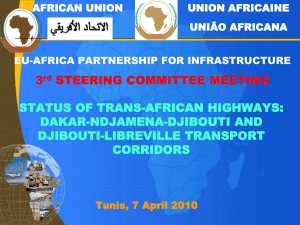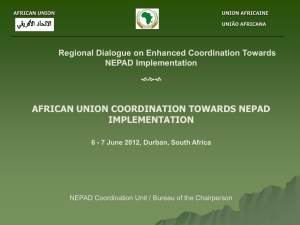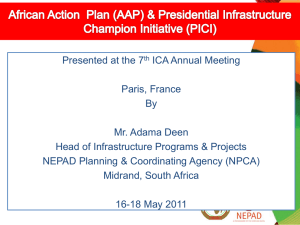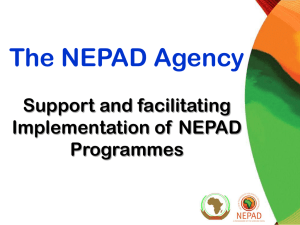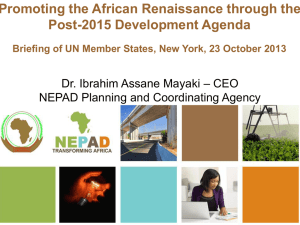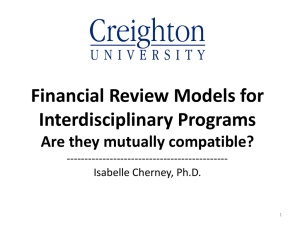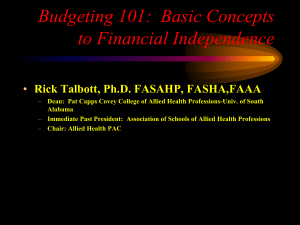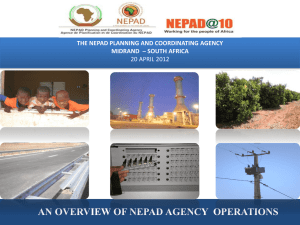UN Regional Coordination Mechanism and its Sub
advertisement
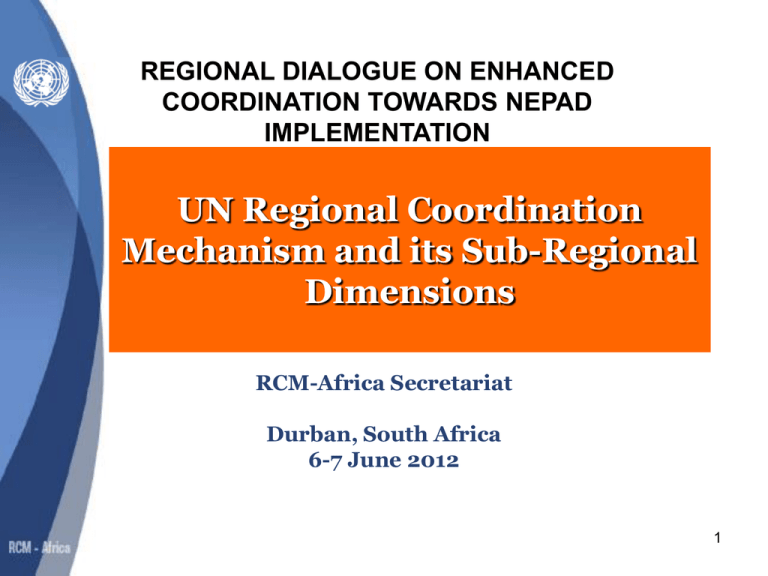
REGIONAL DIALOGUE ON ENHANCED COORDINATION TOWARDS NEPAD IMPLEMENTATION UN Regional Coordination Mechanism and its Sub-Regional Dimensions RCM-Africa Secretariat Durban, South Africa 6-7 June 2012 1 Outline Brief introduction to RCMAfrica Coordinating for better outcomes Major achievements of RCMAfrica SRCMs Harnessing RCM for implementation of NEPAD 2 What is the RCM? A mechanism for enhancing UN system-wide coherence, coordination and cooperation at the regional and sub-regional levels ‘Delivering as one’ in promoting development in Africa and in support of AU and NEPAD 3 Background UN General Assembly Resolution 1998/46 provides imperative for holding regular inter-agency meetings UN Resolution 57/7 called for UN system organisations to coordinate activities in support of NEPAD - 2002 Consultative meetings led to establishment of fullfledged coordination mechanism RCM-Africa transformed into a Joint AU-UN mechanism (Nov 2009) RCM-Africa Sessions held annually 4 Clusters of RCM-Africa Infrastructure Development Industry, Trade & Market Access ECA Governance UNDP UNIDO Environment Population & Urbanization Peace and Security UNOAU ECA/AUC UNEP Joint Secretariat Social and Human Development Advocacy and Communication OSAA WHO Science And Technology UNESCO Agriculture, Food Security & Rural Development FAO Each of the 9 Clusters of RCM-Africa is CoCoordinated by the AU Commission 5 Coordinating for better Outcomes Multiple actors pursuing same goals have to do things to organise themselves that single actors pursuing those same goals would not have to do Coordination refers to these extra organising activities 6 Basic Concepts Coordination presupposes the following: Multiple actors Dependencies among activities Alternative ways of performing desired tasks in a more efficient and cheaper manner Common desired outcomes 7 In the absence of Coordination Over-stretched attention and capacities of beneficiary institutions Overlapping and conflicting tasks Delivery of similar outputs Failure to share common inputs or services, e.g. for administrative purposes Failure to take advantage of existing outputs which may serve as inputs for other tasks Inadequate sharing of resources 8 Coordination Tools/Instruments Sharing of information Meetings (physical, VC, Tel Conference) Joint planning, programming, implementation (Business Plans/PIPs) MoUs Joint Declarations Strategic Documents (Strategic Frameworks/Plans/Directions)9 Main Achievements of RCM Ownership of mechanism by UN and AU Strong leadership by UN and AU at the highest level: Co-chaired by UNDSG and AUC Deputy Chairperson Joint UN-AU RCM-Africa Secretariat Full membership of NEPAD Agency and RECs RCM-Africa deeply entrenched as credible platform for supporting AU and its NEPAD Programme Other parties increasingly indicating interest to collaborate with RCM-Africa 10 Main Achievements (con’t) RCM-Africa more results-oriented Business Plans developed by clusters with clear expected results and performance indicators Annual programme implementation plans prepared Emphasis placed on joint activities Gender and other crosscutting issues mainstreamed in the work RCM Clusters Guidelines for mainstreaming crosscutting issues developed (gender, employment, governance, etc.) SRCMs being established; Business Plans being developed 11 Strategic Actions of RCM-Africa Capacity Building Work Programme Annual work plans Establishment of SRCMs 12 Capacity Building (TYCBP-AU) Declaration on TYCBP-AU signed by UN SG and AUC Chairperson in 2006 TYCBP-AU conceived as UN overall platform for cooperation with AU Objective is to enhance capacity of AUC, African regional organisations to act as effective 13 UN partners TYCBP-AU Work Programme Work Programme for TYCBP-AU developed and endorsed by 12th Session of RCM Results-oriented Work Programme developed in a participatory manner Comprehensive capacity needs assessment of AUC undertaken High-level UN-AU Retreat held at Kiruftu RCM-Africa clusters are developing annual programme implementation plans with capacity building components Work Programme to be extended to other members of AU family (NPCA, APRM, RECs, etc.) TOR for NPCA capacity building work programme already developed 14 Sub-Regional Coordination Mechanisms Significant progress made in establishing SRCMs Joint SRCM for Eastern and Southern Africa launched Process of developing Business Plan for the SRCM underway Business Plan to be validated in July 2012 Task force to design modalities for joint SRCM for Central and Western Africa put in place SRCM already exist in Central Africa 15 RCM and Implementation of NEPAD Work of RCM Clusters revolves around continental (mostly NEPAD) progammes Focal points could help identify the kind of support needed to implement programmes at national level This could then be a factor in determining UN support to AUC/RECs/NPCA in implementation of NEPAD 16 Way Forward NEPAD Focal Points could participate in ICE/SRCM/RCM meetings This could ensure that their concerns are addressed by SROs, SRCMs and RCM ICE could identify areas where member States need assistance from RECs to implement NEPAD projects and for which RCM/SRCM could provide support 17 Thanks 18
